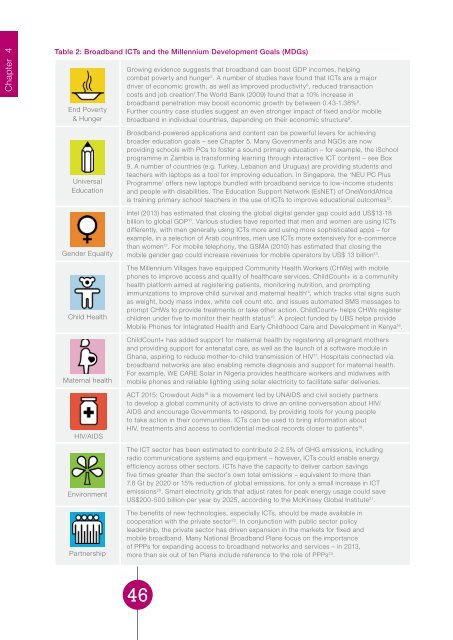DI8xz
DI8xz
DI8xz
You also want an ePaper? Increase the reach of your titles
YUMPU automatically turns print PDFs into web optimized ePapers that Google loves.
Chapter 4Table 2: Broadband ICTs and the Millennium Development Goals (MDGs)End Poverty& HungerGrowing evidence suggests that broadband can boost GDP incomes, helpingcombat poverty and hunger 5 . A number of studies have found that ICTs are a majordriver of economic growth, as well as improved productivity 6 , reduced transactioncosts and job creation 7 .The World Bank (2009) found that a 10% increase inbroadband penetration may boost economic growth by between 0.43-1.38% 8 .Further country case studies suggest an even stronger impact of fixed and/or mobilebroadband in individual countries, depending on their economic structure 9 .UniversalEducationGender EqualityChild HealthMaternal healthHIV/AIDSEnvironmentPartnershipBroadband-powered applications and content can be powerful levers for achievingbroader education goals – see Chapter 5. Many Governments and NGOs are nowproviding schools with PCs to foster a sound primary education – for example, the iSchoolprogramme in Zambia is transforming learning through interactive ICT content – see Box9. A number of countries (e.g. Turkey, Lebanon and Uruguay) are providing students andteachers with laptops as a tool for improving education. In Singapore, the ‘NEU PC PlusProgramme’ offers new laptops bundled with broadband service to low-income studentsand people with disabilities. The Education Support Network (EsNET) of OneWorldAfricais training primary school teachers in the use of ICTs to improve educational outcomes 10 .Intel (2013) has estimated that closing the global digital gender gap could add US$13-18billion to global GDP 11 . Various studies have reported that men and women are using ICTsdifferently, with men generally using ICTs more and using more sophisticated apps – forexample, in a selection of Arab countries, men use ICTs more extensively for e-commercethan women 12 . For mobile telephony, the GSMA (2010) has estimated that closing themobile gender gap could increase revenues for mobile operators by US$ 13 billion 13 .The Millennium Villages have equipped Community Health Workers (CHWs) with mobilephones to improve access and quality of healthcare services. ChildCount+ is a communityhealth platform aimed at registering patients, monitoring nutrition, and promptingimmunizations to improve child survival and maternal health 14 , which tracks vital signs suchas weight, body mass index, white cell count etc. and issues automated SMS messages toprompt CHWs to provide treatments or take other action. ChildCount+ helps CHWs registerchildren under five to monitor their health status 15 . A project funded by UBS helps provideMobile Phones for Integrated Health and Early Childhood Care and Development in Kenya 16 .ChildCount+ has added support for maternal health by registering all pregnant mothersand providing support for antenatal care, as well as the launch of a software module inGhana, aspiring to reduce mother-to-child transmission of HIV 17 . Hospitals connected viabroadband networks are also enabling remote diagnosis and support for maternal health.For example, WE CARE Solar in Nigeria provides healthcare workers and midwives withmobile phones and reliable lighting using solar electricity to facilitate safer deliveries.ACT 2015: Crowdout Aids 18 is a movement led by UNAIDS and civil society partnersto develop a global community of activists to drive an online conversation about HIV/AIDS and encourage Governments to respond, by providing tools for young peopleto take action in their communities. ICTs can be used to bring information aboutHIV, treatments and access to confidential medical records closer to patients 19 .The ICT sector has been estimated to contribute 2-2.5% of GHG emissions, includingradio communications systems and equipment – however, ICTs could enable energyefficiency across other sectors. ICTs have the capacity to deliver carbon savingsfive times greater than the sector’s own total emissions – equivalent to more than7.8 Gt by 2020 or 15% reduction of global emissions, for only a small increase in ICTemissions 20 . Smart electricity grids that adjust rates for peak energy usage could saveUS$200-500 billion per year by 2025, according to the McKinsey Global Institute 21 .The benefits of new technologies, especially ICTs, should be made available incooperation with the private sector 22 . In conjunction with public sector policyleadership, the private sector has driven expansion in the markets for fixed andmobile broadband. Many National Broadband Plans focus on the importanceof PPPs for expanding access to broadband networks and services – in 2013,more than six out of ten Plans include reference to the role of PPPs 23 .46


